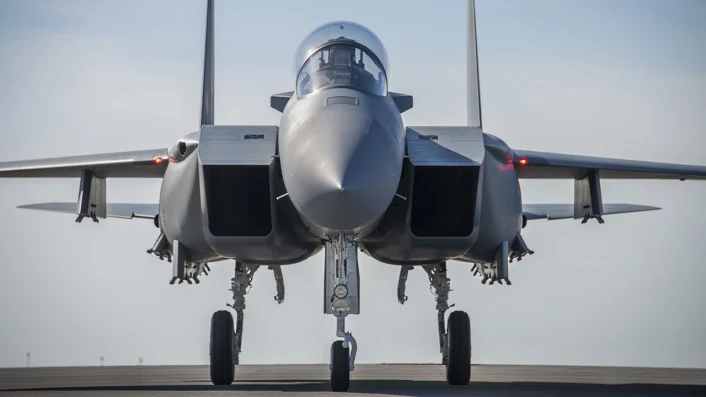The McDonnell Douglas (now Boeing) F-15E Strike Eagle is a supersonic all-weather multirole twin-seat strike fighter derived from a supersonic twin-engined air superiority fighter, the McDonnell Douglas F-15 Eagle.
The F-15E Strike Eagle is a multirole strike fighter developed from the F-15 Eagle air superiority fighter, a plane that was designed primarily for air combat and with little consideration for air-to-ground capabilities.
The F-15 originated during the early phases of the Vietnam War, following concerns over the introduction of the Soviet MiG-25 Foxbat interceptor. Although the MiG-25 was designed to target heavy bombers, it was mistakenly believed in the West to be an air-superiority fighter optimized for air-to-air combat against other fighters.
Before the 1976 defection of a Soviet Foxbat pilot to Japan could uncover the reality behind the MiG-25, the F-15 had already won the F-X contract and, after a first flight in 1972, was already being introduced to combat units.
The resulting fighter, slated to replace the aging fleet of McDonnell Douglas F-4 Phantom IIs, was intended as a “pure” air-to-air fighter, giving rise to the phrase “Not a pound for air to ground”.
At the hands of the Israeli Air Force over Lebanon and Syria and the United States Air Force and Royal Saudi Air Force over Iraq, the F-15 Eagle would prove its worth racking an impressive tally of over 100 victories and no losses in aerial combat. An Israeli F-15 would also prove the robustness of the plane, when its pilot, Zivi Nedivi, was able to land the damaged Eagle (known locally as Baz, the Hebrew word for Falcon) without a wing, also thanks to the lifting-body fuselage!
Despite the required focus solely on air superiority, McDonnell Douglas had quietly included some basic secondary ground attack capabilities in the F-15’s design from the start, and further privately worked on enhancing them and on an F-15-derived interdictor fighter that would be able to replace the General Dynamics F-111 and remaining F-4s.
This new version entered the Dual-Role Fighter competition for a deep interdiction plane, winning over the rival F-16XL in 1984 and finally entering service in 1988 as the F-15E Strike Eagle.
Combining the air-to-air capabilities of the Eagle with the new advanced air-to-ground abilities and additional range due to Conformal Fuel Tanks, the Strike Eagle was able achieve success in foreign sales and has been further developed into the new Boeing F-15EX Eagle II all-weather multirole strike fighter, a plane designed as a newer version of the Strike Eagle with a new cockpit and flight controls, and with payload of 13,400 kg that, using the new AMBER (Advanced Missile and Bomb Ejector Rack) system, allow the F-15EX to carry up to 22 air-to-air missiles or combinations of multiple large standoff weapons.
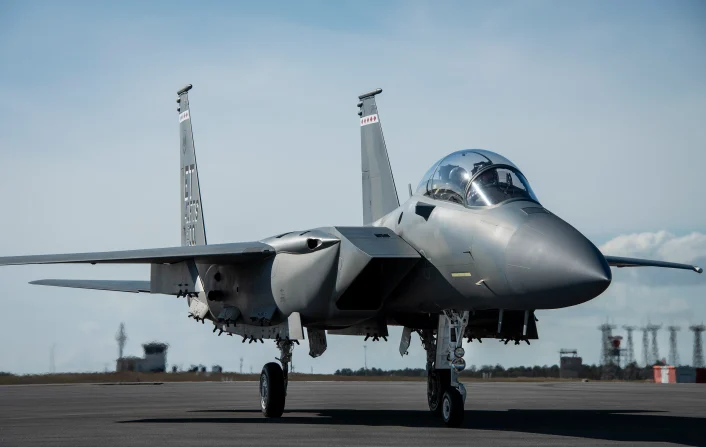
About the Boeing-McDonnell Douglas F-15E Strike Eagle
The Enhanced Tactical Fighter program, later renamed as the Dual-Role Fighter (DRF) competition, started in March 1981 to find a candidate to replace the General Dynamics F-111 with a new plane combining air-to-ground strike capabilities and deep air interdiction with the ability to “self-escort” itself, that is to be able to perform air-to-air combat and not needing fighter and jamming escort.
The major contenders for the DRF program where both derivates of fighters already in service, with the lighter single-engine F-16XL being developed from the F-16 Fighting Falcon ultimately losing against the heavier twin-engined F-15E in 1984, with the Strike Eagle enjoying lower development costs, future growth potential, higher speed, heavier payload and twin-engine redundancy.
The first newly produced F-15E (as the Strike Eagle competed in the DRF with a converted F-15) made its maiden flight on 11 December 1986, while the first production F-15E (of the expected 400 planes) followed suit on 31 March 1987, and the plane finally entered service in April 1988 and achieved initial operational capability in September 1989.
A total of 236 F-15E have been produced for the USAF until 2001, before production continued for foreing customers.
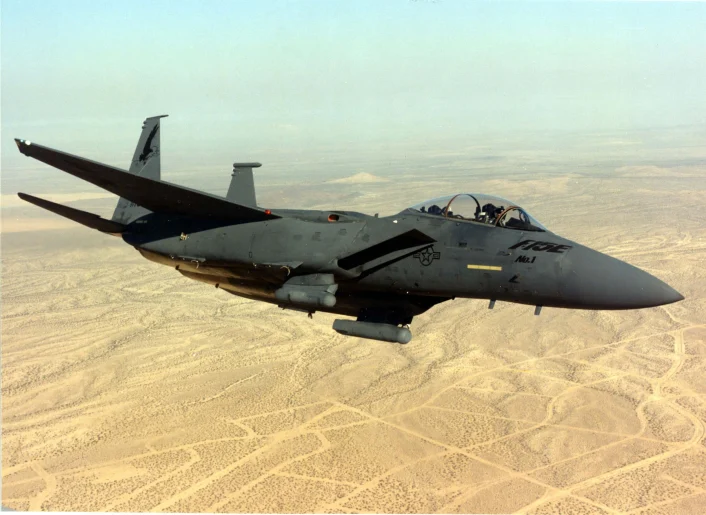
Shortly after introduction, the F-15E would see its combat debut in 1990 in Operation Desert Shield, the military buildup to counter the Iraqi invasion of Kuwait, and afterwards in Operation Desert Storm, the 1991 multinational operation to liberate Kuwait from the troops of Iraqi dictator Saddam Hussein.
24 F-15Es attacked five fixed Scud installations in Iraq on 17 January 1991.
F-15Es also attacked enemy MiG-29s on the opening night of the war, but without success.
On 18 January 1991, the first combat loss of an F-15E happened, when a plane was shot down near Basrah with the loss of both the pilot and the WSO (Weapon Systems Officer), during a strike against an oil and lubricant plant.
The target was heavily defended by many surface-to-air missiles, including mobile Soviet-made SAMs SA-3s Goa, SA-6s Gainful (the same type used by Russian-backed rebels to shot down the civilian Malaysian Airlines flight MH-17 over Eastern Ukraine) and SA-8s Gecko, plus European-made Rolands and heavy presence of anti-aircraft artillery.
Two nights later, the second and final F-15E loss of the war happened, hit by an Iraqi Soviet-made SA-2 Guideline (the same type that shot down the U-2 of Francis Gary Powers), but with the crew fortunately able to eject and survive.
Over the course of Desert Storm, F-15Es destroyed 18 Iraqi jets on the ground at Tallil air base with bombs, took part in “tank plinking” missions with guided bombs against Iraqi tanks, hunted Scud launchers and hit heavily defended targets, with F-15Es also taking part in missions aimed at eliminating Saddam Hussein.
Additionally, Strike Eagles also achieved their first air-to-air kill by hitting a flying Mil Mi-24 attack helicopter with a guided GBU-10 bomb.
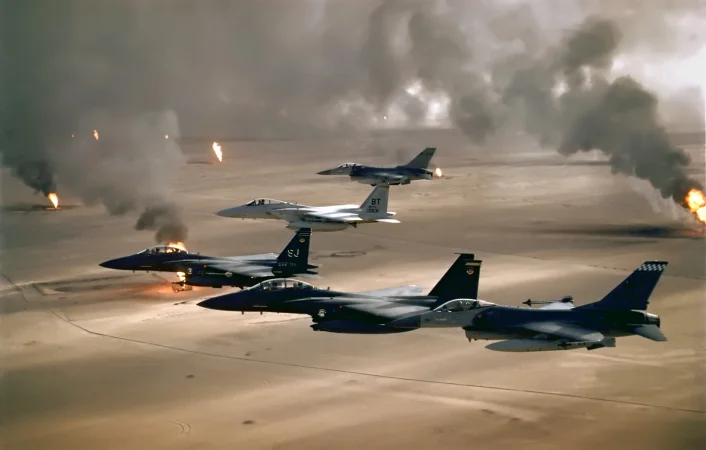
After the end of the Gulf War in 1991, F-15Es took part in almost every conflict involving the United States, starting with No-Fly Zone operations over Iraq (Operations Southern Watch and Northern Watch, during which the wake turbulence of an F-15E caused the crash of an Iraqi Mi-24 intent on an attack on Kurdish refugees, and later Operation Desert Fox and Provide Comfort).
F-15E were later employed during operation Deny Flight in Bosnia and Herzegovina and in the 1999 Operation Allied Force against Serbia, when Strike Eagles forward deployed to Aviano, Italy, were the first to strike Serbian SAM sites.
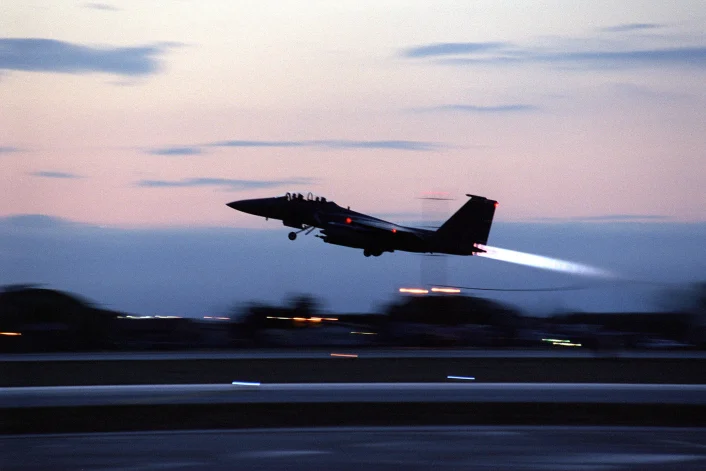
The start of the new millennium brought the F-15Es to Afghanistan in 2001 (Operation Enduring Freedom) and again to Iraq in 2003 (Operation Iraqi Freedom), where they are credited with destroying 65 enemy planes on the ground.
In 2011 F-15Es took part in Operation Odyssey Dawn against Libyan dictator Muammar Gaddafi, with a plane lost to equipment problems (external store weight imbalances).
Starting from September 2014, F-15Es have taken part in Coalition strikes (Operation Inherent Resolve) agains Islamic State (IS or Daesh) targets in Iraq and Syria.
Strike Eagles have also seen combat at the hands of American allies, with Saudi Arabia employing them in Yemen against Houthi militants, and Israel using their F-15I “Ra’am” (Hebrew for “Thunder”) in operations against Hamas militants in Gaza, Hezbollah forces in Lebanon (including the recent strike that hit the underground bunker of Hassan Nasrallah, leader of Hezbollah) and, armed with Air-Launched Ballistic Missiles, even targets in Iran proper.
The USAF has also recently used its F-15Es to defend Israel from Iranian drones, reportedly shooting down over 70 enemy UAVs with Strike Eagles.
As of 2019, the US Air Force operates 219 F-15E planes, while additional 193 airframes are operated by foreign customers (69 by Saudi Arabia, 59 by South Korea, 40 by Singapore, 25 by Israel).
412 airframes are therefore still flying out of the 435 built.
Further F-15E are expected to enter service in the future, but in the F-15EX Eagle II newer version.
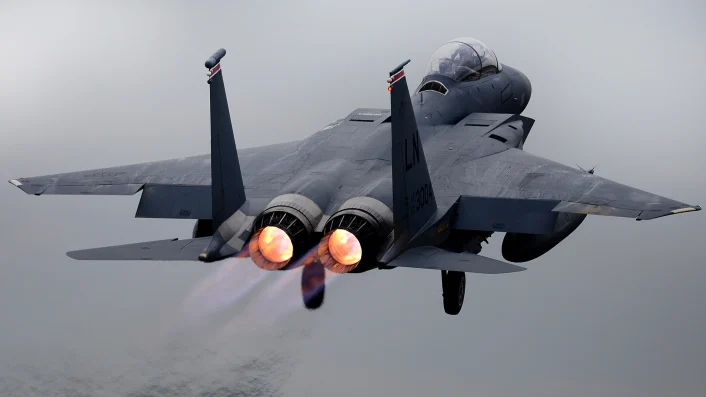
F-15E Strike Eagle: Variants
F-15E Strike Eagle
The production, twin-seat, twin-engined long-range strike and ground-attack aircraft for the USAF. 236 built from 1985 to 2001.
F-15I Ra’am (“Thunder”)
Israeli Air Force version powered by two Pratt & Whitney F100-PW-229 engines and different avionics. 25 built. To be upgraded to F-1EX standard.
F-15K Slam Eagle
South Korean version. 61 built.
First batch of 40 planes and second batch, with Pratt & Whitney F100-PW-229 engines, of 21 planes.
F-15S
Saudi Arabian version. 72 built.
To be upgraded to F-15SR configuration comparable to the newer F-15SA.
F-15SG
Singaporean version. 40 built.
F-15 Advanced Eagle variants (F-15SA, F-15QA, F-15EX Eagle II, F-15IA)
New versions with new fly-by-wire control system, new wing structure, new General Electric F110-129 engines, new cockpit and new avionics. Currently in production.
F-15SA (Saudi Advanced)
First member of the Advanced Eagle family. 84 ordered in 2011 and delivered.
F-15QA (Qatar Advanced) Ababil
Advanced Eagle for the Qatar Emiri Air Force. 33 delivered of the 48 ordered.
F-15EX Eagle II
Further development of the F-15QA for the US Air Force, with General Electric F110-GE-129 engines and Raytheon AN/APG-82(V)1 AESA radar. 8 delivered of the 104 ordered.
Additional orders for foreign countries (Egypt, Indonesia and offers to Poland and Thailand) are being discussed.
F-15IA (Israel Advanced)
Variant of the F-15EX with F110-GE-129 turbofan engines and APG-82(V)1 Active Electronically Scanned Array (AESA) radars a for the Israeli Air Force. 50 ordered and 25 further upgrade kits for bringing the F-15I to F-15IA standard.
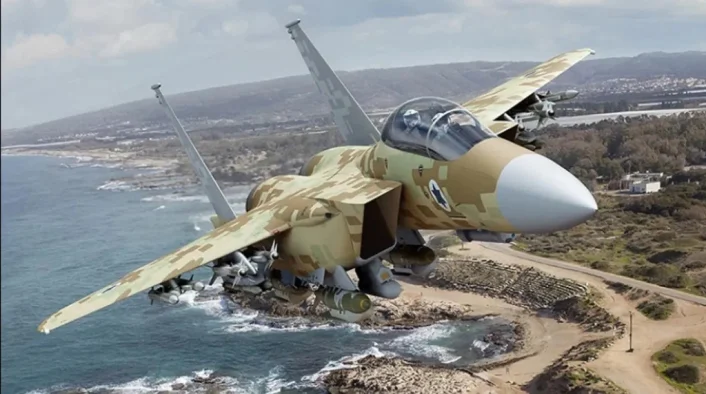
F-15G Wild Weasel
Proposed version to replace the F-4G Wild Weasel in the Suppression of Enemy Air Defenses (SEAD) role.
F-16Cs were instead modified for the role.
F-15SE Silent Eagle
Proposed version with stealth features like internal weapons carriage (inside Conformal Weapon Bays, CWB), radar-absorbent material and canted tail.
First production F-15E, Serial number 86-0183, modified as Silent Eagle demonstrator in 2010.
F-15GSE Global Strike Eagle
Proposed unmanned remotely-piloted variant with 3-stage-to-orbit solid rocket ASAT (Anti-SATellite) missile on the back between the tails. Never built.
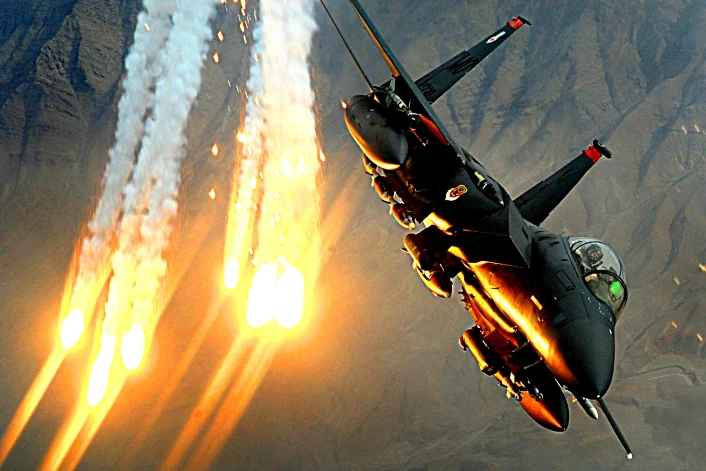
F-15E Strike Eagle: Operators
The F-15E Strike Eagle is in service with 5 countries, with 412 airframes still flying out of the 435 built.
15 airframes were lost by the USAF (5 of them during combat operations, 2 by Iraqi hostile fire with a further 1 crashed in Iraq in 2003, 1 by incident in Libya and 1 crashed in Afghanistan), while 2 South Koreans and 3 Saudi Arabian F-15E were lost in training accidents.
In service with the United States Air Force the 219 F-15Es are operated by:
- 333d Fighter Squadron, 334th Fighter Squadron, 335th Fighter Squadron and 336th Fighter Squadron of the 4th Fighter Wing from Seymour-Johnson AFB, North Carolina.
- 492nd Fighter Squadron and 494th Fighter Squadron of the 48th Fighter Wing based at RAF Lakenheath, United Kingdom.
- 85th Test and Evaluation Squadron and 422nd Test and Evaluation Squadron of the 53rd Wing from Eglin Air Force Base, Florida.
- 17th Weapons Squadron of the 57th Wing from Nellis AFB, Nevada.
- 40th Flight Test Squadron of the 96th Test Wing from Eglin AFB, Florida.
- 389th Fighter Squadron and 391st Fighter Squadron of the 366th Fighter Wing from Mountain Home Air Force Base, Idaho.
- 370th Fighter Squadron of the 414th Fighter Group from Seymour-Johnson AFB, North Carolina.
In service with the Israeli Air Force the 25 F-15Is are operated by:
- 69 Squadron from Hatzerim AFB.
In service with the Republic of Korea Air Force the 59 F-15Ks are operated by:
- 102nd Fighter Squadron, 122nd Fighter Squadron and 110th Fighter Squadron of the 11th Fighter Wing from Daegu Air Base.
In service with the Royal Saudi Air Force the 69 F-15Ss are operated by:
- No. 92 Squadron RSAF of the No. 3 Wing RSAF from King Abdulaziz Air Base.
- No. 6 Squadron RSAF and No. 55 Squadron RSAF of the No. 5 Wing RSAF from King Khalid Air Base.
In service with the Republic of Singapore Air Force the 40 F-15SGs are operated by:
- 142 Squadron “Gryphon”
- 149 Squadron “Fighting Shikra”
- 428th Fighter Squadron of the 366th Fighter Wing from Mountain Home Air Force Base, Idaho, United States (for training).
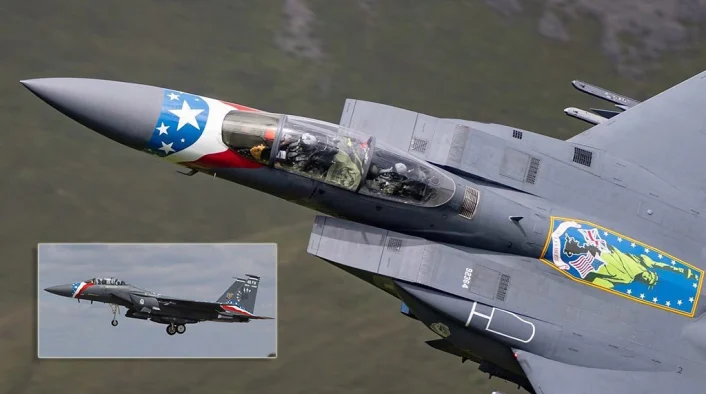
Boeing-McDonnell Douglas F-15E Strike Eagle: Specifications
General Characteristics
- Crew: 2 (pilot and weapon systems officer)
- Length: 63 ft 9.6 in (19.446 m)
- Wingspan: 42 ft 9.6 in (13.045 m)
- Height: 18 ft 6 in (5.64 m)
- Empty weight: 34,600 lb (15,694 kg)
- Max takeoff weight: 81,000 lb (36,741 kg)
- Fuel capacity: 12,915 lb (5,858 kg) internal, 22,267 lb (10,100 kg) with conformal fuel tanks (CFT), 35,550 lb (16,125kg) with three external tanks plus conformal fuel tanks.
- Powerplant: 2 × Pratt & Whitney F100-PW-220 afterburning turbofan, 14,590 lbf (64.9 kN) thrust each dry, 23,770 lbf (105.7 kN) with afterburner each.
Alternative Powerplant: 2 × Pratt & Whitney F100-PW-229 afterburning turbofan, 17,800 lb (79 kN) dry, 29,160 lb (129.7 kN) with afterburner each.
Performance
- Maximum speed: Mach 2.5 (1,650 mph or 2,655 km/h)
- Combat range: 687 nmi (791 mi, 1,272 km) air interdiction
- Ferry range: 2,100 nmi (2,400 mi, 3,900 km) with conformal fuel tanks and three external fuel tanks
- Service ceiling: 60,000 ft (18,288 m)
Armament
- Guns: 1× 20 mm (0.787 in) M61A1 Vulcan 6-barreled Gatling cannon with 500 rounds
- Payload: Up to 23,000 lb (10,400 kg) of external fuel and ordnance on 4 wing pylons, fuselage pylons and bomb racks on Conformal Fuel Tanks.
The F-15E can carry AIM-9 IR short-range Sidewinder AAMs (Air-to-Air Missiles), medium range AIM-7 Sparrow AAMs and long-range radar-guided AIM-120 AMRAAM AAMs, while very long-range AIM-260 JATM AAMs are planned to be integrated.
The F-15E can also carry various air to ground missiles, including the AGM-65 Maverick, AGM-84 Harpoon Anti-Ship missile, AGM-84H/K SLAM-ER stand off precision-guided, air-launched cruise missile, AGM-154 Joint Standoff Weapon (JSOW) glide bomb and the AGM-158 Joint Air-to-Surface Standoff Missile (JASSM) air-launched cruise missile.
South Korean F-15Ks can also launch Taurus KEPD 350 air-launched cruise missile, while Israeli F-15Is can launch Popeye air-to-surface missiles and the Sparrow family of air-launched ballistic missiles.
American F-15EXs can additionally carry the AGM-88 HARM (High-speed Anti-Radiation Missile) and AGM-183 ARRW (“Air-Launched Rapid Response Weapon”) hypersonic air-to-ground ballistic missile.
Moreover, F-15Es can carry most American-made and Israeli bombs, ranging from unguided 531 lb (241 kg) Mark 82 and 2,039 lb (925 kg) Mark 84 to the guided bombs of the Paveway laser-guided family (like the Mk82-based GBU-12 or the Mk84-based GBU-10 and GBU-24) or of the Joint Direct Attack Munition (JDAM) GPS-guided family (like the Mk82-based GBU-38 and the Satellite- and Laser-guided GBU-54 LJDAM or the Mk84-based GBU-31).
Additionally, the F-15E can carry the numerous smaller GBU-39 Small Diameter Bomb (SDB) and larger bombs, like the 4,000 lb (1,800 kg) GBU-28 laser-guided “bunker buster” and the new 5,000 lb (2,268 kg) GBU-72 Advanced 5K Penetrator.
Cluster bombs like the CBU-87 CEM, CBU-89 GATOR and the smart CBU-97 and CBU-105 Sensor Fuzed Weapons can be carried, along with the B-61 nuclear bomb.
South Korean F-15Ks can also launch KGGB (Korean GPS-Guided Bomb) glide-guided bombs, while Israeli F-15Is have in their arsenal the SPICE (Smart, Precise Impact, Cost-Effective) family of optically- and GPS-guided precision-guided bombs.
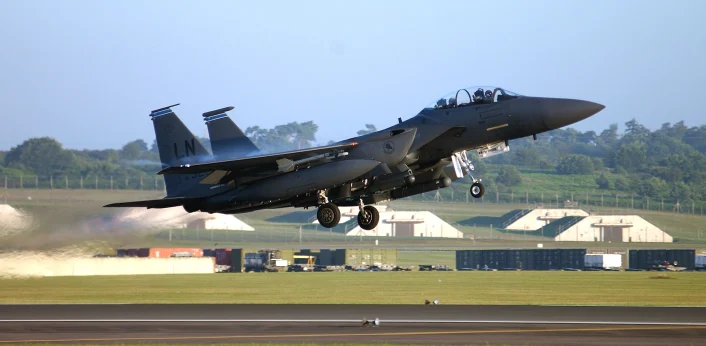
Top F-15E Strike Eagle Milestones
- F-15 first flight: July 27, 1972
- F-15 introduction: Jan. 9, 1976
- Enhanced Tactical Fighter / Dual-Role Fighter (DRF) program started: March 1981
- DRF program awarded to the F-15E: Feb. 24, 1984
- Start of F-15E production: July 1985
- First flight of F-15E: Dec. 11, 1986
- First flight of the production F-15E: Mar. 31, 1987
- F-15E delivery: April 1988
- F-15E in service: Sept. 30, 1989
- F-15E first combat deployment: August 1990
- F-15E first combat sortie: Jan. 17, 1991
- F-15E first combat loss: Jan. 18, 1991
- F-15E first air-to-air kill: Feb. 14, 1991
- F-15S first combat sortie: November 2009
- F-15 Advanced Eagle first flight: Feb. 20, 2013
- F-15EX Eagle II first flight: Feb. 2, 2021
- F-15EX Eagle II introduction: July 2024
- F-15E shooting down over 70 UAVs: April 13-14, 2024
